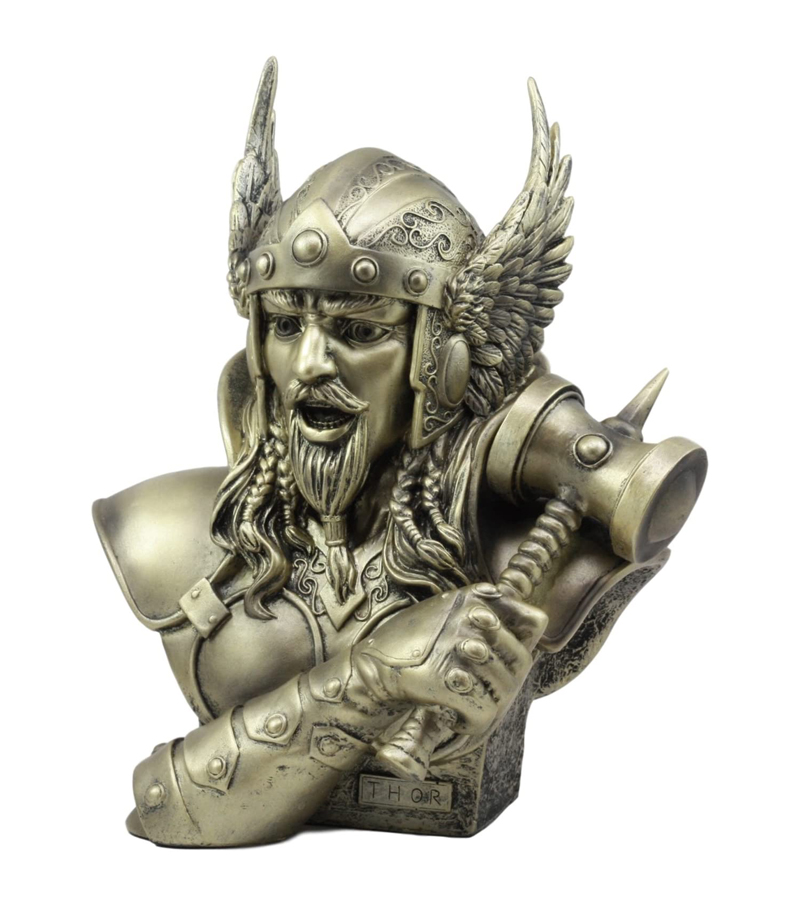Thor Odinson Wielding Mjolnir Hammer Bust Statue
This Thor Odinson God of Thunder Statue is made of designer composite resin, hand painted and polished individually. In the battle of Ragnarok, Thor will defeat the midgard serpent Jörmungandr with the swing of his Mjolnir Hammer. Thor is seen in battle outfit, with crossed long swords, his horned helmet and fearsome mail armor. The prince of Asgard shows his quality, strength and bravery in this ill fated war. This beautiful Thor statue depicts Thor Odinson Wielding the Mjolnir Hammer, fully clad in armor and battle attire. It is a bust statue so he will a gorgeous decor for your home. In Norse mythology, Thor is a Hammer-wielding God associated with lightning, thunder, storms, sacred groves and trees, strength, the protection of mankind, hallowing, and fertility. Thor is a prominently mentioned god throughout the recorded history of the Germanic peoples, from the Roman occupation of regions of Germania, to the Germanic expansions of the Migration Period, to his high popularity during the Viking Age, when, in the face of the process of the Christianization of Scandinavia, emblems of his hammer, Mjolnir, were worn and Norse pagan personal names containing the name of the god bear witness to his popularity.
Due to the nature of the Germanic corpus, narratives featuring Thor are only attested in Old Norse, where Thor appears throughout Norse mythology. Norse mythology, largely recorded in Iceland from traditional material stemming from Scandinavia, provides numerous tales featuring the god. Thor wields the Hammer Mjolnir, wears the Belt Megingjörð and the Iron Gloves Járngreipr, and owns the Staff Gríðarvölr. Thor’s exploits, including his relentless slaughter of his foes and fierce battles with the monstrous serpent Jörmungandr, and their foretold mutual deaths during the events of Ragnarök, are recorded throughout sources for Norse mythology. Into the modern period, Thor continued to be acknowledged in rural folklore throughout Germanic-speaking Europe. Thor is frequently referred to in place names, the day of the week Thursday bears his name (modern English Thursday derives from Old English Þunresdæg, “Þunor’s day“, and names stemming from the pagan period containing his own continue to be used today, particularly in Scandinavia. Thor has inspired numerous works of art and references to Thor appear in modern popular culture. Like other Germanic deities, veneration of Thor is revived in the modern period in Heathenry “contemporary Germanic Paganism“.
The English weekday name Thursday comes from Old English Þunresdæg, meaning “day of Þunor“. It is cognate with Old Norse Þórsdagr and with Old High German Donarestag. All of these terms derive from the Late Proto-Germanic weekday Þonaresdag “Day of Þunaraz“, a calque of Latin Iovis Dies “Day of Jove“, modern Italian giovedì, French jeudi, Spanish jueves. By employing a practice known as interpretatio germanica during the Roman period, ancient Germanic peoples adopted the Latin weekly calendar and replaced the names of Roman gods with their own. Beginning in the Viking Age, personal names containing the theonym Thórr are recorded with great frequency, whereas no examples are known prior to this period. Thórr-based names may have flourished during the Viking Age as a defiant response to attempts at Christianization, similar to the wide scale Viking Age practice of wearing Thor’s hammer pendants. The Mjolnir so, is the hammer of the thunder god Thor in Norse mythology, used both as a devastating weapon and as a divine instrument to provide blessings. The hammer is attested in numerous sources, including 11th century runic Kvinneby amulet, and the Poetic Edda, a collection of eddic poetry compiled in the 13th century, and the Prose Edda, a collection of prose and poetry compiled in the 13th century.
The hammer was commonly worn as a pendant during the Viking Age in the Scandinavian cultural sphere, and Thor and his hammer occur depicted on a variety of objects from the archaeological record. Today the symbol appears in a wide variety of media and is again worn as a pendant by various groups, including adherents of modern Heathenry. The etymology of the hammer’s name, Mjolnir, is disputed among historical linguists. Old Norse Mjolnir developed from Proto-Norse melluniaR and one proposed derivation connects this form to Old Church Slavonic mlunuji and Russian molnija meaning “lightning” (either borrowed from a Slavic source or both stemming from a common source) and subsequently yielding the meaning “lightning-maker“. Another proposal connects Mjolnir to Old Norse mjǫll meaning “new snow” and modern Icelandic mjalli meaning “the color white“, rendering Mjolnir as “shining lightning weapon“. Finally, another proposal connects Old Norse Mjolnir to Old Norse mala meaning “to grind” and Gothic malwjan “to grind“, yielding Mjolnir as meaning “the grinder“. Thor Odinson Wielding Mjolnir Hammer Bust Statue measures: 15 inches / 38 cm x 15 inches / 38 cm x 10 inches / 25.5 cm.
Thor Odinson God of Thunder Statue on Amazon.
Thor Odinson God of Thunder Statue on eBay.
Vikings Statues and Busts Statues.




You must be logged in to post a comment.